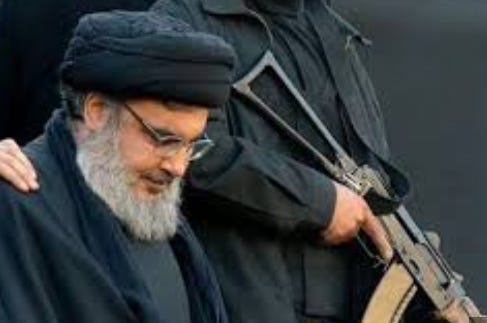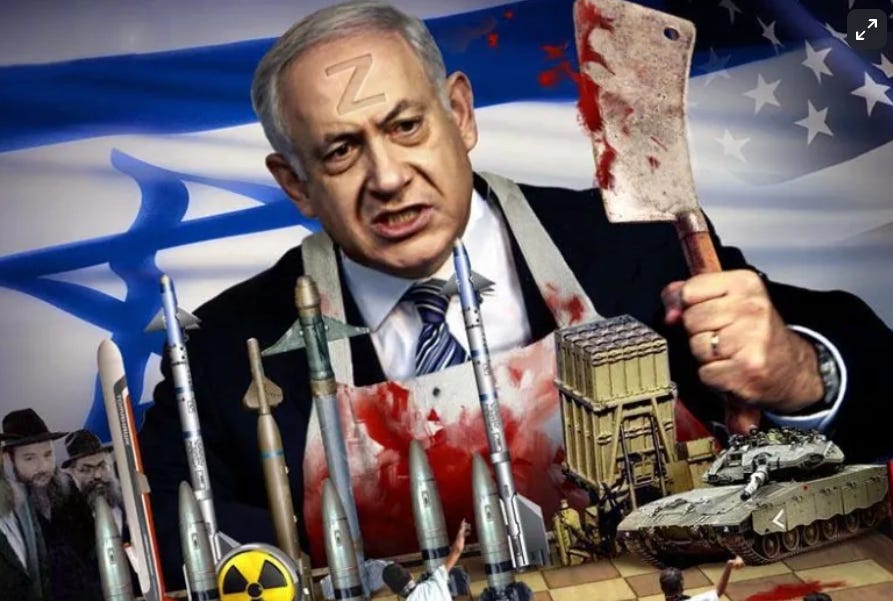Hezbollah's Hassan Nasrallah Faces His Destiny
Dead or Alive This Leader Hasrallah Is Loved and Revered by Millions
The towering figure of Hassan Nasrallah is one of the core leaders animating the worldwide religious community of Shiite Muslims. This Shiite heritage is an essential core element of the Axis of Resistance whose capital is Tehran. Tehran is also the national capital of the Islamic Republic of Iran. The first purpose of the Axis is to resist the expansionary course of the US-Israeli quest for control and dominance over Occupied Palestine.
The starting point for this outburst in Lebanon is the Israeli mass murder in Gaza and the West Bank. Suddenly Israel has changed the focus hoping to draw attention away from the IDF’s debacle in Gaza. The new preoccupation of the Netanyahu government is the extermination of some of the big population groups in Lebanon. Is Israel seeking to conquer and occupy more of West Asia?
Currently the Israeli bombing attacks are falling with particular savagery on the Dahiyeh district of Beirut. Hundreds of thousands of people are fleeing the madness as best they can.
Was Hassan Nasrallah killed in the attack on what Israeli government claims was bombed out headquarters of Hezbollah?
Is Nasrallah dead or alive?
Born in 1960, Hassan Nazrallah joined Hezbollah in 1982 in response to Israel’s invasion of Lebanon. Later Nasrallah went on to study in Iran where he collaborated with key figures in the Islamic Revolution.
A much improved Hezbollah was the result of Nasralla’s endeavours in Iran. Hezbollah combines elements of military organization, social services, and spiritual cultivation. In more recent times Nasrallah worked closely with the legendary Qasem Soleimani who proved to be very gifted in formulating, applying and adapting military tactics.
In 1992 Nasrallah became the head of Hezbollah after his successor, Abbas al-Musawi, was assassinated by Israeli agents.
Born in 1979, Hassan Hasrallah’s eldest son was killed in battle by Israeli soldiers battle in 1997.
https://india.shafaqna.com/EN/the-journey-of-sayyid-muhammad-hadi-nasrallah/
In recent weeks, many Hezbollah commanders have been martyred.
Hassan Nasrallah is a beloved figure to multitudes of people throughout the world. These multitudes include hundreds of millions of Muslims as well as the many independent-minded thinkers of varied backgrounds who honour the Hezbollah leader as an exemplary embodiment of an honourable religious warrior. Nasrallah has had to face some setbacks but, all and all, he has repeatedly showed himself to be a superior strategist when it came to planning for defensive warfare and participation in the political dramas of Lebanese politics.
Hassan Nasrallah can navigate military theory and then set his strategic concepts into motion in the battle field with poise, authority, defiance, and discipline.
The Axis of Resistance includes Hamas, a Sunni group with roots in the Muslim Brotherhood. It includes the Yemen’s Houthis— Ansar Allah— the new Lords of the Sea Sea. The Axis includes Shiite militias in Iraq and the Assad government of Syria. The newer groups in the Axis all look to Hezbollah for ideas and for models to emulate.
The Axis of Resistance is a work-in-progress as it transcends many new frontiers of alliance and support.
As the US-supplied massive bombs that reigned down on the men, women and children of Dahiyeh, Netanyah addressed the UN General Assembly as follows.
“I say to you, until Israel - until the Jewish state - is treated like other nations, until this anti-Semitic swamp is drained, the UN will be viewed by fair-minded people everywhere as nothing more than a contemptuous farce.”
Hassan Nasrallah Interviewed by Julian Assange in 2012
Who is longtime Hezbollah leader Hassan Nasrallah?
BY BASSEM MROUE
Updated 8:44 PM MDT, September 27, 2024
Ruhollah Khomeini
BEIRUT (AP) — Hezbollah leader Hassan Nasrallah has led the Lebanese militant group for the past three decades, transforming it into one of the most powerful paramilitary groups in the Middle East.
Israeli airstrikes Friday afternoon knocked out six buildings in Beirut’s southern suburb of Haret Hreik, the largest strike in the Lebanese capital in nearly a year of fighting between Israel and Hezbollah.
The Israeli military said the strike, which killed and wounded dozens of people, hit the headquarters of Hezbollah in Beirut. Three major Israeli TV channels said Nasrallah was the target of the strikes in Beirut’s southern suburbs, which has not been officially confirmed by Israel. Hezbollah officials did not comment.
Here’s a look at the leader:
Who is Hassan Nasrallah?
Under the leadership of the 64-year-old Nasrallah, Hezbollah has fought wars against Israel and taken part in the conflict in neighboring Syria, helping tip the balance of power in favor of President Bashar Assad.
An astute strategist, Nasrallah reshaped Hezbollah into an archenemy of Israel, cementing alliances with Shiite religious leaders in Iran and Palestinian militant groups such as Hamas.
Idolized by his Lebanese Shiite followers and respected by millions of others across the Arab and Islamic world, Nasrallah holds the title of sayyid, an honorific meant to signify the Shiite cleric’s lineage dating back to the Prophet Muhammad, the founder of Islam.
A fiery orator viewed as an extremist in the United States and much of the West, he is also considered a pragmatist compared to the militants who dominated Hezbollah after its founding in 1982, during Lebanon’s civil war.
Despite the power he wields, Nasrallah has lived largely in hiding for fear of an Israeli assassination.
How he rose to power
Born in 1960 into a poor Shiite family in Beirut’s impoverished northern suburb of Sharshabouk, Nasrallah was later displaced to south Lebanon. He studied theology and joined the Amal movement, a Shiite political and paramilitary organization, before becoming one of Hezbollah’s founders.
Hezbollah was formed by Iranian Revolutionary Guard members who came to Lebanon in the summer of 1982 to fight invading Israeli forces. It was the first group that Iran backed and used as a way to export its brand of political Islam.
Nasrallah built a power base as Hezbollah became part of a cluster of Iranian-backed factions and governments known as the Axis of Resistance.
Two days after its leader, 39-year-old Sayyed Abbas Musawi, was killed in an Israeli helicopter gunship raid in south Lebanon, Hezbollah chose Nasrallah as its secretary-general in February 1992.
Five years later, the United States designated Hezbollah a terrorist organization.
Under Nasrallah, Hezbollah was credited with leading the war of attrition that led to the withdrawal of Israeli troops from south Lebanon in 2000, after an 18-year occupation. Nasrallah’s eldest son, Hadi, was killed in 1997, fighting against Israeli forces.
After Israel’s withdrawal from southern Lebanon in 2000, Nasrallah rose to iconic status both within Lebanon and throughout the Arab world. His messages were beamed on Hezbollah’s own radio and satellite TV station.
That status was further cemented when, in 2006, Hezbollah fought Israel to a stalemate during the 34-day war.
When Syria’s civil war erupted in 2011, Hezbollah fighters rushed in, siding with Assad’s forces — even though Hezbollah’s popularity took a dive as the Arab world ostracized Assad.
Nasrallah’s role in the current conflict
A day after the Israel-Hamas war started on Oct. 7, Hezbollah began attacking Israeli military posts along the border calling it a “backup front” for Gaza.
In speeches throughout the conflict, he has argued that Hezbollah’s cross-border strikes had pulled away Israeli forces that would otherwise be focused on Hamas in Gaza and insisted that Hezbollah would not halt its attacks on Israel until a cease-fire is reached in Gaza.
Nasrallah has maintained a defiant tone, even as tensions rose dramatically in recent weeks with Israel announcing a new phase in the conflict intended to push Hezbollah back from the border to allow thousands displaced from northern Israel to return.
Israel launched strikes killing top military commanders with the group and was blamed for the explosion of thousands of communications devices, mainly used by Hezbollah members, that killed 37 people and wounded thousands.




















HAMAS was created by MOSSAD and CIA, so it can be guaranteed that the Jews will always know where to shoot! The plebs are betrayed everywhere!
Seyed Nastallah’s death, if it occurred, will be a murder too from for the racist, Zionist entity